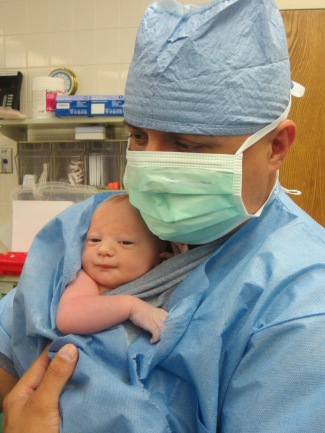I’m going to try to write this post without sounding like I’m on a rant. Deep breath and…
I want to talk about the immediate postpartum of a cesarean birth. First, let me mention, that I’ve only attended cesareans at Greenville Memorial. My experience is limited and what I’ve heard of other local hospitals is just that–hearsay.
What bothers me the most about preparing my clients for cesarean birth is the inconsistency of practices. I honestly don’t know what to tell them to expect anymore. Examples:
1) Sometimes I’m permitted in the operating room. If the doctor says I can attend, then the anesthesiologist must ok it. I receive that answer second-hand from a nurse. Sometimes after I’m already dressed in scrubs, I’m told “the anesthesiologist said ‘no’.”
2) In that case, I’m taken to the mom’s recovery room to await her arrival. Since Greenville Memorial doesn’t permit recovery room “rooming-in,” I stay with mom while dad goes with baby. Recently, however, I was not allowed in recovery at all. Like the anesthesiologist decision, it was at the say-so of one person–the recovery room nurse. In that situation, the mom was left alone in recovery while dad stayed with baby. I learned that if I was her immediate family, the nurse would let me in. I’ve never heard that one before. I wonder if it is written down anywhere?
3) If baby is healthy, he is taken to the nursery where inane people smile at the babies lying alone in isolettes behind the glass. I have so much trouble with this scene. The babies are alone. These newborns are not skin-to-skin with a parent, are lying on their back under bright lights, and are surrounded by unfamiliar open space and smells. Why are people smiling at this? But I digress. The inconsistency is how quickly and easily the dad is able to bust his newborn out of the nursery. Sometimes, it is no big deal. Dad walks over to the nursery door and requests his baby. Sometimes, he is told that the baby must be observed for an hour. Sometimes 2 hours. Sometimes he is told the baby must have a bath first. I’ve actually started suggesting my clients flirt or fib to get their baby. I watched one dad do both! Tip: go to the Mom/Baby info desk, ask for the room number of your wife, then go tell the nursery that you have been assigned a room and need to take your baby to his room.
What logic suggests it is best practice to keep baby alone in an isolette immediately after birth? When every medical journal is promoting immediate skin-to-skin and early initiation of breastfeeding, why this practice? Babies do best in arms. Why do newborn nurseries still exist? Now I’m sure Greenville Memorial has a logistical reason for this practice but I doubt it is based on logic.
What my issue boils down to is this: how your baby is handled after a cesarean birth is often determined by one person’s whim or mood.
Another example: one of my clients wanted the baby to be placed skin-to-skin on her chest following her cesarean. She and her doctor discussed how that would work. Everyone agreed. Doctor exited. OR nurse entered. She said “absolutely not. the OR is too cold for skin-to-skin.” And so ensued a tense discussion that ended with a sour OR nurse influencing much of what subsequently occurred in the OR and in recovery.
In some hospitals (even St. Francis), families remain in recovery together. In some hospitals, babies are routinely placed skin-to-skin on mom immediately and in a few hospitals, permitted to nurse in the operating room. I’ve heard of one Australian doctor who encourages the mother to “birth” her own baby during cesareans. He delivers the head and then guides the mom to pull the baby to her chest, cord still uncut. I’m not sure how the whole sterile field issue is handled in that situation. The point is that there are ways to make a cesarean birth feel more like, well, birth.
Step 4 of the Mother-Baby Friendly Hospital Initiative is to initiate breastfeeding within one hour of birth. And while I’ve had one client who nursed her baby immediately after leaving the OR (before baby was removed to the nursery), this is not the norm. On average, for the cesareans I’ve attended, the delay has been more like 2-4 hours.
And in case you’re wondering why breastfeeding within the first hour of birth is so important, here are a few reasons:
1) Mom’s body regulates the baby’s body temperature.
2) Baby is less stressed, calmer, and has steadier breathing and heart rates.
3) Baby is exposed to bacteria from the mother which are mostly harmless, or against which the mother’s milk contains protective factors. Mom’s bacteria colonizes the baby’s gut and skin. These compete with more harmful bacteria from health providers and the environment, and so prevent them from causing infection.
4) Baby receives colostrum which, among many other protective factors, stimulates the baby to have bowel movements so that meconium is cleared quick. This helps get rid of the substances in the baby’s body that produce jaundice and may help reduce it.
5) Touching, mouthing, and sucking at the breast stimulates oxytocin to release in the mom. Oxytocin causes the uterus to contract which may reduce maternal bleeding. It stimulates other hormones which cause a mom to feel calm, relaxed, and “in love” with her baby. And finally, it stimulates the flow of milk from the breast.
6) Mom experiences joy. The process of bonding is strengthened.
If you had a cesarean birth or attend cesareans, what has been your experience? What are the practices like at other hospitals?
